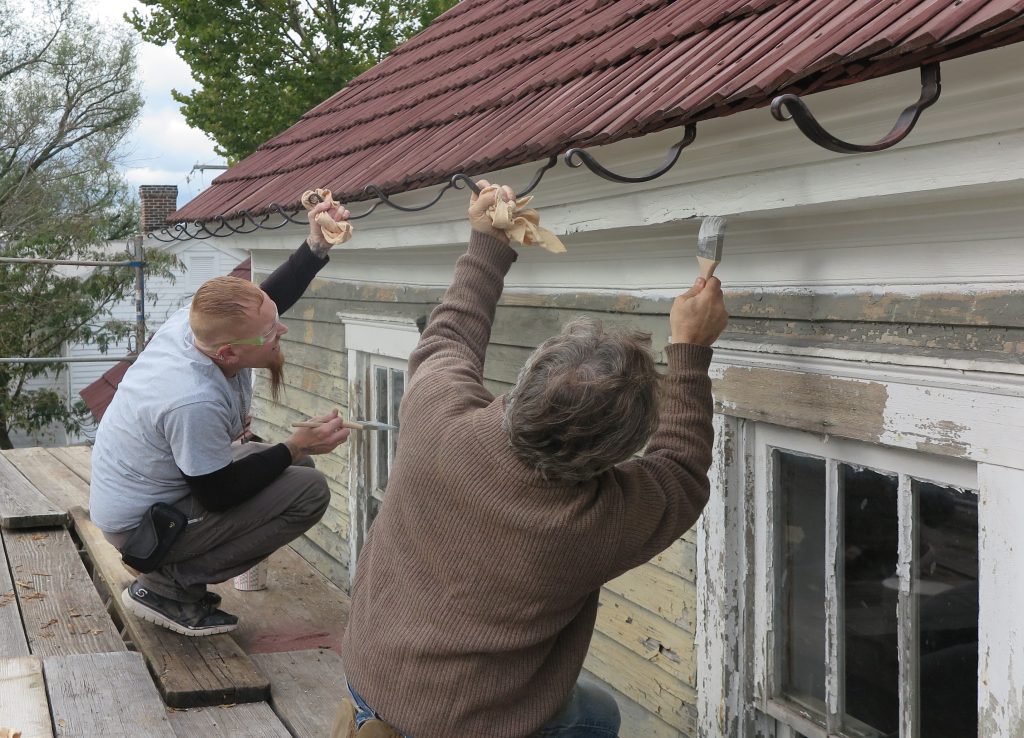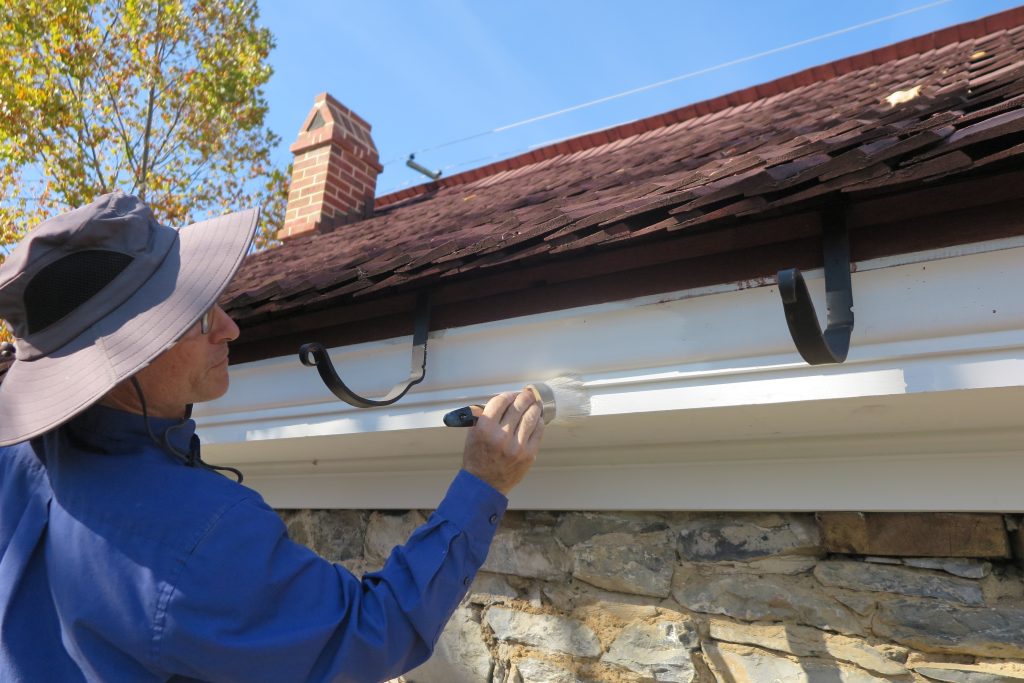On October 3rd Vintage, Inc. began the priming of the soffit and crown of the Stone House. (See image below.) This is no ordinary paint job. As we explained in our previous issue, the crown molding, soffit, and top weatherboard on the log side of the Stone House are original and date to when the log side was raised to its current height in 1804. Because of this we have been extra careful with the way we treat these features.
In previous issues we have made mention of our use of linseed oil paint on the shingles we installed over the two sides of the Stone House, and we discussed its benefits and historical applications. In this post we will go into more depth on the subject of linseed oil paint and the reasons why this paint job will not only protect our original wood features but also survive the test of time.

Many of us who are in the historic architecture preservation business have been coming to the consensus that modern paints are the cause of serious deterioration in exterior woodwork on historic properties. The fact that the historic woodwork in question was originally harvested from old-growth forests during the eighteenth and early nineteenth centuries makes this discovery even more distressing. The evidence is showing that for over a hundred years during the time that linseed oil paints were being used, this exterior woodwork remained in relatively good condition even though it was being exposed to the elements. During the 1930s we start to see true linseed oil-based paints being infused and eventually replaced by synthetic resin alkyd paints derived from petroleum-based chemical ingredients. As the environmental and cleanup concerns mounted over these alkyd paints, acrylic paints were chosen as a “better” alternative. With their faster drying time and easier cleanup, latex or acrylic paints quickly became the new standard. These paints are essentially plastic that encapsulates a wood surface. This sounds great until you realize that water eventually finds a way behind that plastic coating and gets trapped. Trapped moisture in any wood, no matter what its species or quality, causes rot. As the wood rots the paint begins to flake. The painted surfaces that do not flake wear out from ultraviolet light damage. In five years, you are back to scraping, sanding, and painting again. This gets expensive. Never mind the fact that you are also having to sometimes replace rotted wood. One of the few benefits of plastic paints is that they stretch as the wood behind them expands and contracts, shifts, or settles. Even so, these plastic paints do not penetrate the undelaying wood surface, which remains hygroscopic (able to absorb moisture from the environment). As a result, the wood becomes vulnerable to deterioration from within.

The benefits of linseed oil paint make it clear why it has been used for architectural applications since ancient Roman times. Linseed oil has lower surface tension than water. This makes linseed oil paint able to penetrate farther under the wood surface. As a rule, this type of paint is absorbed deeper into the wood than water-based paints are able to reach. Moreover, linseed oil itself naturally repels water. Linseed oil paints do not form a watertight surface like plastic paints. Instead, they allow what little moisture that does get into the wood to evaporate out through the painted surface. Because of this water never gets trapped under the painted surface of the wood. Unlike acrylic and alkyd paints which require scraping, chemical stripping, and sanding as they crack and flake off, linseed oil painted surfaces are much more maintainable. As the linseed oil dries out of the painted surface, typically over the course of around five years, the pigment takes on a matte or chalky appearance. Even at this point the wood surface is still protected by the oil remaining in its subsurface. The cosmetic quality of the painted surface can be renewed by brushing on a thin coat of pure boiled linseed oil or adding a thin new coat of the same linseed oil paint. Because linseed oil paint does not loosen, crack, flake, or peel, it does not need to be scraped, stripped, or sanded before a new coat of it is applied. Nevertheless, when you apply linseed oil paint over surfaces previously painted with acrylic and alkyd paints (as we are doing with this project), it is best to prepare the surface by removing as much of the old paint layers as possible. To learn more about linseed oil paints and if they might be right for your projects, see “Resurrecting Linseed Oil Paint” by Justin Fink in the October 2024 issue of Fine Homebuilding. Our thanks to David Logan of Vintage, Inc. for sharing his knowledge on this subject.
